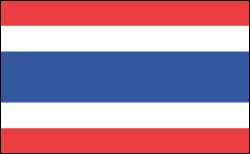THAILAND

Geography: Thailand occupies the western half of the Indochinese peninsula and the northern two-thirds of the Malay Peninsula in southeast Asia. Its neighbors are Burma (Myanmar) on the north and west, Laos on the north and northeast, Cambodia on the east, and Malaysia on the south. Thailand is about the size of France.
Government: Constitutional monarchy.
History: The Thais first began settling their present homeland in the 6th century, and by the end of the 13th century ruled most of the western portion. During the next 400 years, they fought sporadically with the Cambodians to the east and the Burmese to the west. Formerly called Siam, Thailand has never experienced foreign colonization. The British gained a colonial foothold in the region in 1824, but by 1896 an Anglo-French accord guaranteed the independence of Thailand. A coup in 1932 demoted the monarchy to titular status and established representative government with universal suffrage.
At the outbreak of World War II, Japanese forces attacked Thailand. After five hours of token resistance Thailand yielded to Japan on Dec. 8, 1941, subsequently becoming a staging area for the Japanese campaign against Malaya. Following the demise of a pro-Japanese puppet government in July 1944, Thailand repudiated the declaration of war it had been forced to make in 1942 against Britain and the U.S.
By the late 1960s the nation's problems largely stemmed from conflicts brewing in neighboring Cambodia and Vietnam. Although Thailand had received $2 billion in U.S. economic and military aid since 1950 and had sent troops (paid by the U.S.) to Vietnam while permitting U.S. bomber bases on its territory, the collapse of South Vietnam and Cambodia in spring 1975 brought rapid changes in the country's diplomatic posture. At the Thai government's insistence, the U.S. agreed to withdraw all 23,000 U.S. military personnel remaining in Thailand by March 1976.

Map of Thailand
Ruler: King Bhumibol Adulyadej
(1946)
Prime Minister: Gen. Prayuth Chan-ocha
(2014)
Land area: 197,595 sq mi (511,771 sq km);
total area: 198,455 sq mi (514,000 sq km)
Population (2014 est.): 67,741,401 (growth rate: 0.35%); birth rate: 11.26/1000; infant mortality rate:
9.86/1000; life expectancy: 74.18
Capital and largest city (2011):
Bangkok, 8.426 million
Monetary unit: baht
Languages:
Thai (official) 90.7%, Burmese 1.3%, Other 8%, English (secondary language of
the elite) (2010 est.)
Ethnicity/race:
Thai 95.9%, Burmese 2%, other 1.3%, unspecified 0.9% (2010 est.)
Religions:
Buddhist (official) 93.6%, Muslim 4.9%, Christian 1.2%, other 0.2%, none 0.1% (2010 est.)
Literacy rate: 93.5% (2005 est.)
Economic summary: GDP/PPP (2013
est.): $673 billion; per capita $9,900. Real growth rate:
2.9%. Inflation: 2.2%. Unemployment: 0.7%.
Arable land: 30.71%. Agriculture: rice, cassava (manioc, tapioca),
rubber, corn, sugarcane, coconuts, soybeans. Labor force:
39.38 million (2013 est.); agriculture 38.2%, industry 13.6%, services 48.2% (2011
est.). Industries: tourism, textiles and garments,
agricultural processing, beverages, tobacco, cement, light
manufacturing such as jewelry and electric appliances, computers and
parts, integrated circuits, furniture, plastics, automobiles and
automotive parts; world's second-largest tungsten producer and
third-largest tin producer. Natural resources: tin, rubber,
natural gas, tungsten, tantalum, timber, lead, fish, gypsum,
lignite, fluorite, arable land. Exports: $225.4
billion
(2013 est.): electronics, computer parts, automobiles and
parts, electrical appliances, machinery and equipment, textiles and
footwear, fishery products, rice, rubber.
Imports: $219 billion (2013 est.): capital goods,
intermediate goods and raw materials, consumer goods, fuels.
Major trading partners: U.S., Japan, China, Singapore,
Hong Kong, Malaysia, Indonesia, UAE, Australia (2012).
Communications: Telephones: main lines
in use: 6.391 million (2012); mobile cellular: 84.075 million (2012).
Broadcast media: 6 terrestrial TV stations in Bangkok
broadcast nationally via relay stations - 2 of the networks are owned
by the military, the other 4 are government-owned or controlled, leased
to private enterprise, and are all required to broadcast
government-produced news programs twice a day; multi-channel satellite
and cable TV subscription services are available; radio frequencies
have been allotted for more than 500 government and commercial radio
stations; many small community radio stations operate with low-power
transmitters (2008). Internet Service
Providers (ISPs): 3.399 million (2012). Internet users: 17.483 million
(2009).
Transportation: Railways: total: 4,071
km (2008). Highways: total: 180,053 km (2006 est.). Waterways: 4,000 km principal
waterways; 3,701 km with navigable depths of 0.9 m or more
throughout the year; numerous minor waterways navigable by
shallow-draft native craft (2011). Ports and harbors: Bangkok, Laem
Chabang, Map Ta Phut, Prachuap Port, Si Racha. Airports:
101 (2013).
International disputes:
Separatist violence in Thailand's predominantly Muslim southern
provinces prompt border closures and controls with Malaysia to stem
terrorist activities; Southeast Asian states have enhanced border
surveillance to check the spread of avian flu; talks continue on
completion of demarcation with Laos but disputes remain over several
islands in the Mekong River; despite continuing border committee talks,
Thailand must deal with Karen and other ethnic rebels, refugees, and
illegal cross-border activities, and as of 2006, over 116,000 Karen,
Hmong, and other refugees and asylum seekers from Burma; Cambodia and
Thailand dispute sections of boundary; in 2011 Thailand and Cambodia
resorted to arms in the dispute over the location of the boundary on
the precipice surmounted by Preah Vihear temple ruins, awarded to
Cambodia by ICJ decision in 1962 and part of a planned UN World Heritage
site; Thailand is studying the feasibility of jointly constructing the
Hatgyi Dam on the Salween river near the border with Burma; in 2004,
international environmentalist pressure prompted China to halt
construction of 13 dams on the Salween River that flows through China,
Burma, and Thailand; 140,000 mostly Karen refugees fleeing civil strife,
political upheaval and economic stagnation in Burma live in remote
camps in Thailand near the border.
-------------------- o --------------------
No comments:
Post a Comment